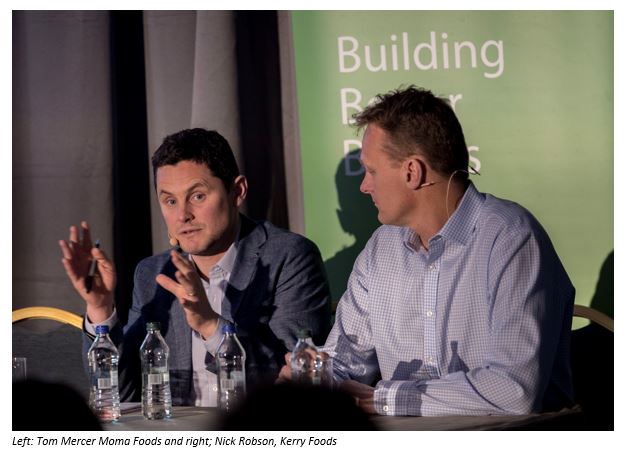Lessons from Bord Bia’s Brand Forum, May 2018
Two presentations from very contrasting businesses; a small start-up English brand Moma and one of Ireland’s biggest food businesses, Kerry Group. However, as we’ll see, the similarities in the two presentations were more revealing than the differences.
Tom Mercer, executive chairman and founder of Moma Foods was up first to tell the absorbing story of his twelve-year-old brand. Tom comes from a farming background and after university, he joined management consultancy Bain & Co but hankered after the entrepreneurial life and founded Moma in 2006. It was based on the premise that people, especially in bustling urban areas wanted more healthy breakfast options which could be accommodated in their hectic lifestyles. He began with porridge, the healthiest breakfast option, and taking a leaf out of the Innocent casebook researched the new concept latterly ‘on the go’ by handing out samples at busy early morning tube stations in central London. The brand’s start-up credentials were amplified by distributing the brand from a makeshift stall under a railway arch in Waterloo. The four key brand attributes were; tasty, healthy, filling and fast but it is significant that he emphasised ‘taste’ above the other three attributes.
The brand has recorded phenomenal growth at a time when all of the competitive ready-to-eat breakfast brands are in decline and because its initial appeal to young, middle-class urban sophisticates it should be poised for further growth as the choices of these cohorts are gradually adopted by the rest of society.
Undoubtedly the main factor in the success of the brand has been the identification of emerging food and meal trends among the young, affluent, urban class with an above average interest in taste and healthy eating; trends that Bord Bia are continually monitoring for Irish food businesses. But Moma has also been active in all aspects of innovation and marketing communications. They have an active new product development programme launching a range of mueslis and smoothies in addition to their porridge products which now come in a variety of formulations. At a time of even more concentrated retailer power, continuous product innovation is one of the most important strategies for keeping retailer brands at bay. Particular attention is paid to design and all the packs are functional but aesthetically pleasing to a more design-conscious target market. No brand will succeed today without an active and creative marketing communications strategy and Moma use digital platforms, traditional advertising media, experiential marketing and public relations. Tom Mercer emphasised the latter pointing out that all it takes is a little imagination to create stories that will interest journalists. The brand personality is also developed through the use of interesting quirky copy on the packs; including an explanation of the brand name-Making Oats More Awesome! There’s nothing outstandingly original in the Moma case study, no breakthrough in terms of product development or award-winning creative communication but it is rare to see every single element in the marketing mix performed at such a universally high level of professionalism which is why you should study every aspect of the brand in detail.
The second presentation was from Nick Robinson, recently appointed Chief Marketing Officer of Kerry Foods, a global food brand leader whose portfolio includes Cheesestrings, Denny, Dairygold, Mattessons Fridge Raiders and Richmond sausages. Nick brings a wealth of global brand management experience to the job having previously managed iconic brands including Guinness, Coca-Cola and Stella Artois. Although he shared some highly creative new TV campaigns for Cheesestrings, Richmond and Dairygold Nick’s presentation mainly drew on his experience managing global brands in an omnichannel, multiple touchpoint digital age to give us a philosophical reflection on six enduring truths of marketing and six new lessons that must be applied today as a result of our rapidly changing environment.
He began with the most enduring truth of all; great products are at the heart of all great brands, a fact all too often overlooked by over-enthusiastic brand managers blinded by the glare of the latest digital gismos. Great brands must have a unique blend of appeals; to reason, to the senses and to the emotions if they are to have any long-term and especially export potential. The second truth is that recruitment is more important than retention. This point is obviously influenced by Byron Sharp’s widely disseminated work emphasising the critical importance of continuous recruitment because all brands are continuously losing customers for a variety of reasons. Thirdly we must be aware that; efficiency in reach is complicated now but still very important. This refers to the importance of keeping track of our budgets in the changed media landscape. Nick’s fourth mantra; execution is more important than strategy, is a reminder of the sometimes neglected role of production values and how stunning production values enhance even the most brilliant strategies. His next lesson will be familiar to all Brand Forum members; deep and current consumer insight is like oxygen for a winning brand company. Enough said. Finally, at a time when the claims of ‘big data’ are becoming more and more extravagant he reminded us that; insight is not the same as data, however much of it you have.
Nick’s second sextet of reflections on our current exciting but confusing marketing communications landscape took up most of his presentation and began with a timely reminder that the only way to impose some kind of order on the new terrain is to create coherence through visual identity. To illustrate the point he showed how the somewhat disparate aspects of the Fridge Raiders identity had been given greater visual coherence through a revamped design. His second point is now well-established but still worth repeating; be driven by purpose. The public is now looking for the brands they are willing to be associated with to be driven by a more noble purpose than maximising shareholder value. The next one follows directly from that; be the brand you want to be. So when you have agreed on your brand purpose be sure to have the courage of your convictions. Successful brands are always characterised by a bold ambition and Nick’s fourth recommendation echoed this; show up big and you will be big. The concept of pricing is evolving in the digital age from standardised to dynamic pricing; setting flexible prices based on market demand and capacity utilization. Long established in the hospitality and airline market dynamic pricing is now spreading to all markets and the fifth recommendation reflected this; get the price right. The final recommendation; marketing always goes last, was a reminder that the marketing function is not a standalone discipline operating on the periphery of a business, it is central to every aspect of a business and must be integrated into all business operations.
Both presentations have enduring relevance for all Brand owners. For further details on Bord Bia’s Brand Forum contact Niamh.machale@BordBia.ie and visit www.bordbia.ie/brandforum










